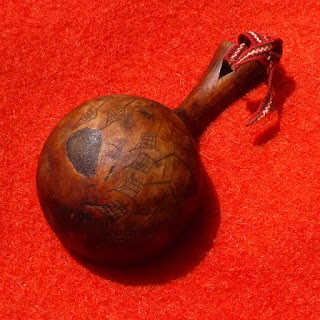 |
| "Canoes in a Fog" by Frances Anne Hopkins |
During the fur trade era French-Canadian voyageurs and Native American hunters traveling by canoe often carried wooden canoe cups (sometimes called belt cups), a practical accessory that allowed them to dip drinking water from a lake or stream while paddling a canoe. Until drinking unfiltered water became identified as dangerous in the 1970s, the tradition of carrying canoe cups continued with sportsmen.
Canoe cups were typically made from a tree burl, often maple or birch, that was hollowed out and shaped with crooked knife. The cups were sometimes decorated with incised, relief-carved, painted, or burned (pyrography) motifs of indigenous flora and fauna.
Attached to the cup was usually a piece of deer or moose hide cordage, and a twig or carved toggle, which allowed the cup to hang from the sash or belt.
My hand-carved canoe cup (pictured here) is engraved and decorated with burnt wood details of a trout or whitefish on each side. It measures about 4¾" long by 3¼" wide by 2¼" deep, and is unsigned. It was made by a Northern Cree (Atikamekw) Indian from the Manawan area of Quebec, Canada (about 160 kilometers northeast of Montreal).
The Atikamekw are the indigenous inhabitants of the area they refer to as Nitaskinan ("Our Land"), in the upper Saint-Maurice River valley of Quebec. The Atikamekw language, is a variety of the Cree language. Their name, which literally means "lake whitefish", is sometimes also spelt "Atihkamekw", "Attikamekw", "Attikamek", or "Atikamek". The French colonists referred to them as Têtes-de-Boules, meaning "Ball-Heads" or "Round-Heads" because of the shape of their headdress.
 |
| Carved Burl canoe cup from author's collection |
 |
| Carved Moose canoe cup from author's collection |
Update: April 4, 2019
More elaborately carved examples of "Canoe Cups" or "Belt Cups" can be seen at:
Great Lakes or Eastern Woodlands Indian Canoe Cup
My latest discovery is — I believe — a Great Lakes or Eastern Woodlands Indian Canoe Cup or Belt Cup.
It was found in Minnesota. It has incised carved designs that appear to be a vine and leaves.
The cup portion is s a diminutive 2 1/2 inches in diameter and it is just 4 3/8 inches in length.
It’s carved from a wood burl of an undetermined species. It has characteristics of both maple or ash.
It is dated "1899" on the top of the handle. I was hoping it was earlier, but it is what it is.
Because of its tiny size I believe it may have been lovingly carved for a child.
More elaborately carved examples of "Canoe Cups" or "Belt Cups" can be seen at:
Belt Cup, c. 1820, Anishinaabe, Ottawa or Ojibwa -- http://www.seattleartmuseum.org/exhibitions/indigenous (search - "Belt Cup")
Exceptional Northeast Carved Wood Belt Cup -- https://www.skinnerinc.com/auctions/2685B/lots/245
Northeast Carved and Painted Wood Canoe Cup -- https://www.skinnerinc.com/auctions/2563B/lots/332
Eastern Woodlands carved wood Belt Cup. c. 1760 -- https://fineart.ha.com/itm/american-indian-art/wood-sculpture/an-eastern-woodlands-carved-wood-belt-cupc-1760/a/5161-50330.s
Update -- Woodlands Indian Canoe Cup on PBS -- http://www.pbs.org/wgbh/roadshow/season/6/miami-fl/appraisals/native-american-artifacts--200102A34/
Update -- Woodlands Indian Canoe Cup on PBS -- http://www.pbs.org/wgbh/roadshow/season/6/miami-fl/appraisals/native-american-artifacts--200102A34/
 |
| Canoe Cup appraised on PBS Antiques Roadshow at $15-20,000 |
Update 2022:
My friend Petr Luňák is an anthropologist and a talented craftsman. We have been corresponding for a few years because we share an interest in America’s early history. To make a long story short… I just received a carved wooden canoe cup that Petr carved for me.
-- o -- o --
Return to beginning of book… http://laprairie-voyageur-canoes.blogspot.com/2017/03/ripples-introduction-contents-and.html
Index - Ripples from La Prairie Voyageur Canoes
Canoe Collectibles unrelated to the fur trade...
http://a-drifting-cowboy.blogspot.com/2013/02/sporting-collectibles-canoes.html
If you found some ancestors please let me know on La Prairie Voyageurs Facebook










No comments:
Post a Comment